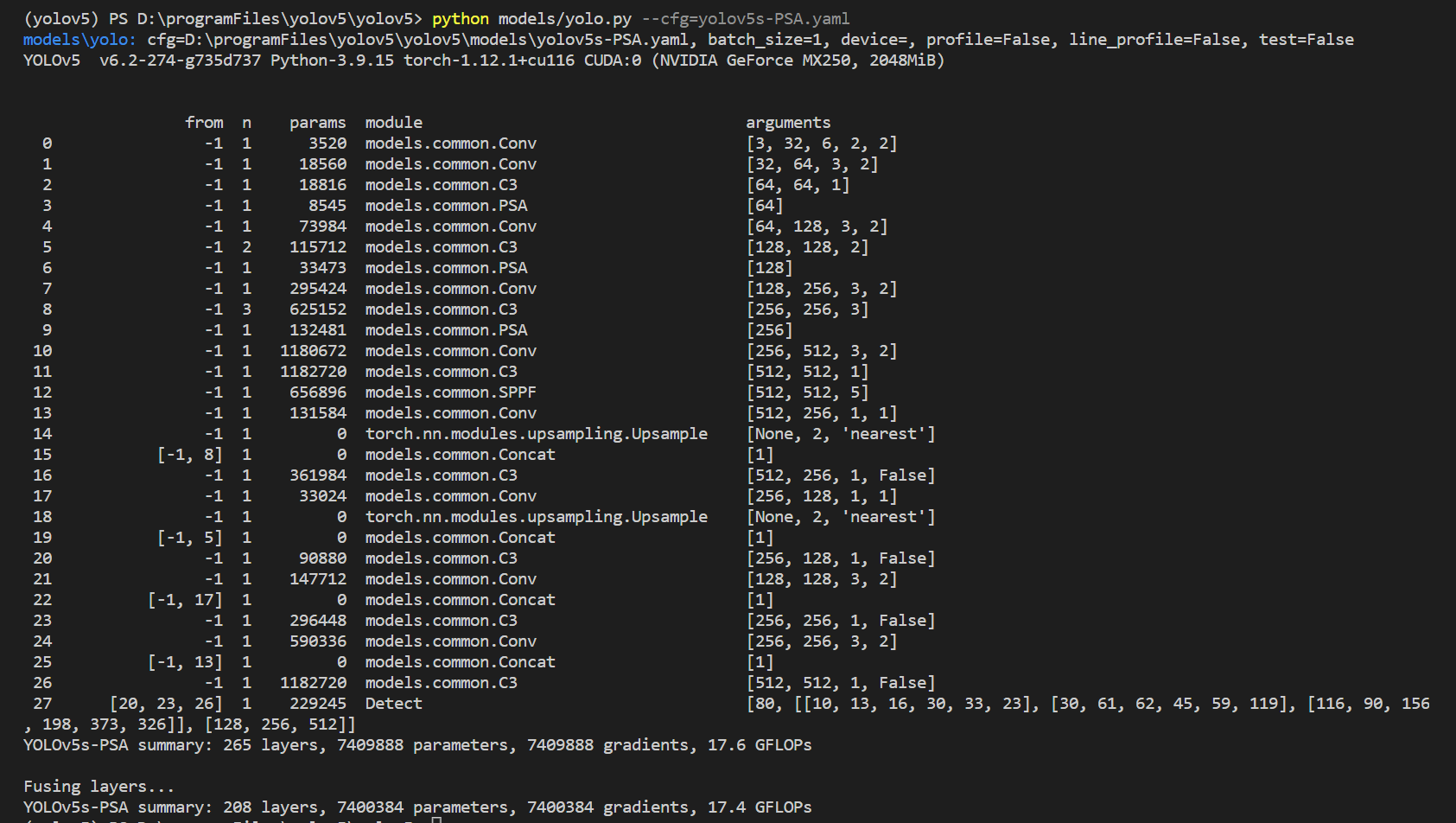Yolov5添加PSA极化自注意力机制
最近在学习目标检测领域的yolov5算法,发现PSA(极化自注意力机制)对于该算法的改进可能有用,于是在网上几经搜寻,无果,遂自己动手写了一个,现分享给大家
PSA极化自注意力机制来源
论文链接: Polarized Self-Attention: Towards High-quality Pixel-wise Regression
代码地址: https://github.com/DeLightCMU/PSA
使用效果
 图1 原图
图1 原图
 图2 平行极化
图2 平行极化
 图3 顺序极化
图3 顺序极化
极化过程示意图
作者在网上没有找到pytorch框架下的PSA模块源码,于是根据论文中的流程自己动手写了一个。
论文中的流程图:
源代码
classPSA_Channel(nn.Module):def__init__(self, c1)->None:super().__init__()
c_ = c1 //2# hidden channels
self.cv1 = nn.Conv2d(c1, c_,1)
self.cv2 = nn.Conv2d(c1,1,1)
self.cv3 = nn.Conv2d(c_, c1,1)
self.reshape1 = nn.Flatten(start_dim=-2, end_dim=-1)
self.reshape2 = nn.Flatten()
self.sigmoid = nn.Sigmoid()
self.softmax = nn.Softmax(1)
self.layernorm = nn.LayerNorm([c1,1,1])defforward(self, x):# shape(batch, channel, height, width)
x1 = self.reshape1(self.cv1(x))# shape(batch, channel/2, height*width)
x2 = self.softmax(self.reshape2(self.cv2(x)))# shape(batch, height*width)
y = torch.matmul(x1, x2.unsqueeze(-1)).unsqueeze(-1)# 高维度下的矩阵乘法(最后两个维度相乘)return self.sigmoid(self.layernorm(self.cv3(y)))* x
classPSA_Spatial(nn.Module):def__init__(self, c1)->None:super().__init__()
c_ = c1 //2# hidden channels
self.cv1 = nn.Conv2d(c1, c_,1)
self.cv2 = nn.Conv2d(c1, c_,1)
self.reshape1 = nn.Flatten(start_dim=-2, end_dim=-1)
self.globalPooling = nn.AdaptiveAvgPool2d(1)
self.softmax = nn.Softmax(1)
self.sigmoid = nn.Sigmoid()defforward(self, x):# shape(batch, channel, height, width)
x1 = self.reshape1(self.cv1(x))# shape(batch, channel/2, height*width)
x2 = self.softmax(self.globalPooling(self.cv2(x)).squeeze(-1))# shape(batch, channel/2, 1)
y = torch.bmm(x2.permute(0,2,1), x1)# shape(batch, 1, height*width)return self.sigmoid(y.view(x.shape[0],1, x.shape[2], x.shape[3]))* x
classPSA(nn.Module):def__init__(self, in_channel, parallel=True)->None:super().__init__()
self.parallel = parallel
self.channel = PSA_Channel(in_channel)
self.spatial = PSA_Spatial(in_channel)defforward(self, x):if(self.parallel):return self.channel(x)+ self.spatial(x)return self.spatial(self.channel(x))
Yolov5添加PSA极化自注意力的步骤
第一步,将☝️上面的PSA模块代码粘贴到models/common.py文件下。
第二步,构建添加PSA模块的网络。在models文件夹下面创建yolov5s-PSA.yaml文件,并且将👇下面的内容粘贴上去。
# YOLOv5 🚀 by Ultralytics, GPL-3.0 license# Parametersnc:80# number of classesdepth_multiple:0.33# model depth multiple 深度——神经网络的层数, 宽度——每层的通道数, 分辨率——是指网络中特征图的分辨率width_multiple:0.50# layer channel multipleanchors:-[10,13,16,30,33,23]# P3/8-[30,61,62,45,59,119]# P4/16-[116,90,156,198,373,326]# P5/32# YOLOv5 v6.0 backbonebackbone:# [from, number, module, args][[-1,1, Conv,[64,6,2,2]],# 0-P1/2[-1,1, Conv,[128,3,2]],# 1-P2/4[-1,3, C3,[128]],[-1,1, PSA,[64]],# PSA[-1,1, Conv,[256,3,2]],# 3-P3/8[-1,6, C3,[256]],[-1,1, PSA,[128]],# PSA[-1,1, Conv,[512,3,2]],# 5-P4/16[-1,9, C3,[512]],[-1,1, PSA,[256]],# PSA[-1,1, Conv,[1024,3,2]],# 7-P5/32[-1,3, C3,[1024]],[-1,1, SPPF,[1024,5]],# 9]# YOLOv5 v6.0 headhead:[[-1,1, Conv,[512,1,1]],[-1,1, nn.Upsample,[None,2,'nearest']],[[-1,8],1, Concat,[1]],# cat backbone P4[-1,3, C3,[512,False]],# 13[-1,1, Conv,[256,1,1]],[-1,1, nn.Upsample,[None,2,'nearest']],[[-1,5],1, Concat,[1]],# cat backbone P3[-1,3, C3,[256,False]],# 17 (P3/8-small)[-1,1, Conv,[256,3,2]],[[-1,17],1, Concat,[1]],# cat head P4[-1,3, C3,[512,False]],# 20 (P4/16-medium)[-1,1, Conv,[512,3,2]],[[-1,13],1, Concat,[1]],# cat head P5[-1,3, C3,[1024,False]],# 23 (P5/32-large)[[20,23,26],1, Detect,[nc, anchors]],# Detect(P3, P4, P5)]
第三步,在终端输入命令
python models/yolo.py --cfg=yolov5s-PSA.yaml
,运行后可查看网络细节。
到这一步大功告成,我们就可以愉快的使用这个网络了😊
版权归原作者 不会数分的程序员不是好会计 所有, 如有侵权,请联系我们删除。